Ships are my arrows, the sea my bow, the world my target. - Robert Thier
26 October 2019, Kumasi
Homey Lodge 144GHC (R411)
Using public transport, we today explored three aspects of the Ashanti (Asante) Kingdom, in the 18th century one of Africa’s wealthiest. It was a conglomeration of city states, conquered by the British in 1902. Its capital was Kumasi. We ended our day shopping at Shoprite in the Kumasi City Hall, and eating Chinese there, a nice change from chicken and rice.
In Ntonso, northeast of the city, we visited the Adinkra Cloth Village; in Adanmwase, the Kente Cloth Village, and in Besease, a traditional shrine.
adinkrabrand.com: Adinkra are symbols that represent concepts or aphorisms. The historical roots of these symbols date back to the times of the Asante people of Ghana, West Africa. [Some examples…]
“Except for God” - Symbol of the Supremacy of God. This unique and beautiful symbol is ubiquitous in Ghana. It is by far the most popular for use in decoration, a reflection on the deeply religious character of the Ghanaian people.
“Return and get it” - A symbol of the importance of learning from the past. Sankofa is an African word from the Akan tribe in Ghana.The literal translation of the word and the symbol is “it is not taboo to fetch what is at risk of being left behind.” Essentially every experience in life should leave you wiser than it met you and even if it was a bad experience, you would have learnt not how to go about it.
“Siamese crocodiles” - Symbol of Democracy and Unity. The Siamese crocodiles share one stomach, yet they fight over food. This popular symbol is a reminder that infighting and tribalism are harmful to all who engage in it.
“Crocodile” - Symbol of adaptability. The crocodile lives in the water, yet breathes the air, demonstrating an ability to adapt to circumstances.
“Ram’s Horns” - Symbol of humility together with strength. The ram will fight fiercely against an adversary, but it also submits humbly to slaughter, emphasizing that even the strong need to be humble.
kentecloth.net: Kente Cloth is local to Ghana, a country located in West Africa. Kente Cloth there was worn by royalty. It is hand woven in wooden looms and is of very high worth. It comes in a variety of patterns, colors and designs, each of which have different meanings. According to Ghanaian mythology, kente cloth was first created when 2 friends watched how a spider wove its web. By mimicking the actions of the spiders, they created Kente cloth the same way. This story, wether true or not, shows the harmony between Ghanaians and mother nature. As we look back in history, the Kente cloth is reserved for the Kings and is associated with royalty and sacredness. This is worn only during important times even in today’s world. Though the cloth has widespread acceptance and usage still it is held in high esteem among the Akan tribe and the Ghanaians in general. The Kente cloth is one of the most famous and wanted fabric in the whole of Africa. Kente cloth is more than just clothing to be worn however. For the Ghanaians this represents the history, philosophy, oral literature, religious beliefs, political thought and aesthetic principles of life. The various colours in the cloth symbolize various aspects of life. Blue symbolizes peace and harmony. Gold colour mostly worn by kings in ancient times symbolizes royalty, power, esteemed status, spiritual purity and holiness. This colour is also used by the high priests in ancient times. Pink and purple colours are associated with women. White and grey colours symbolize sanctification, holiness, cleansing rituals and are mostly used by priests and holy people. Lots of patterns have been invented over the times for different occassions. The Obaakofoo Mmu Man pattern symbolizes democratic rule. Emaa Da stands for novel creativity and knowledge from experience. Sika Fre Mogya symbolizes responsibility to share monetary success with one’s relations. These showcase the good nature and kind heartedness of the Ghanaian people.
worldheritagesite.org: The Asante Traditional Buildings are the only surviving examples of traditional Ashanti architecture. Their design and construction, consisting of a timber framework filled up with clay and thatched with sheaves of leaves, is rare nowadays. All designated sites are shrines, but there have been many other buildings in the past in the same architectural style. They have been best preserved in the villages, away from modern construction and warfare. The WHS consists of a number of buildings (10, 12 or 13?) around Kumasi in central Ghana. Kumasi was once the capital of the great Ashanti Empire. The buildings consist of four rooms around a quadrangular courtyard. Three of the rooms (those for drumming, singing and cooking) are open, while the fourth (the actual shrine) is closed to all but the priest and his assistants. The inner courtyards are usually littered with fetishes. The shrine is home to Obosomfie, the spiritual abode of a deity, who manifests itself through a fetish priest. Some of the enlisted buildings still have priests, some don't. The buildings traditionally have steep thatched roofs. Their lower walls are painted orange/red, and the upper walls are whitewashed. The walls hold symbolic murals, like those on the adinkra cloth.

Adinkra symbols on fabric

Adinkra symbols on fabric

Charl pounding bark for dye

Adinkra symbols carved into calabash

Adinkra symbols carved into calabash

Adinkra symbols on fabric

Adinkra symbols on fabric

Adinkra symbols on fabric

Adinkra symbols on fabric

Adinkra symbols on fabric

Kente cloth - "Madiba"

Kente cloth
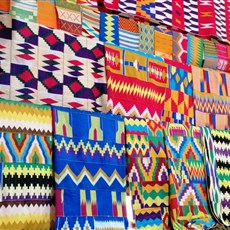
Kente cloth

Kente cloth weavers

Kente cloth weavers
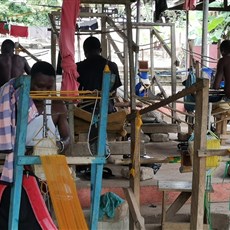
Kente cloth weavers
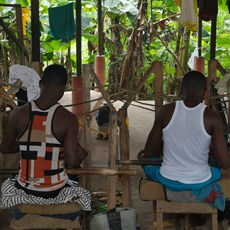
Kente cloth weavers

Asante traditional shrine

Asante traditional shrine
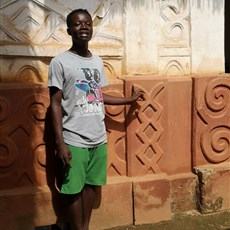
Asante traditional shrine

Asante traditional shrine

Asante traditional shrine
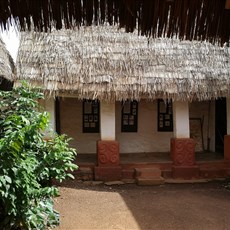
Asante traditional shrine

Besease

Tro-tro to Kumasi

Kumasi mall

Shoprite, Kumasi mall